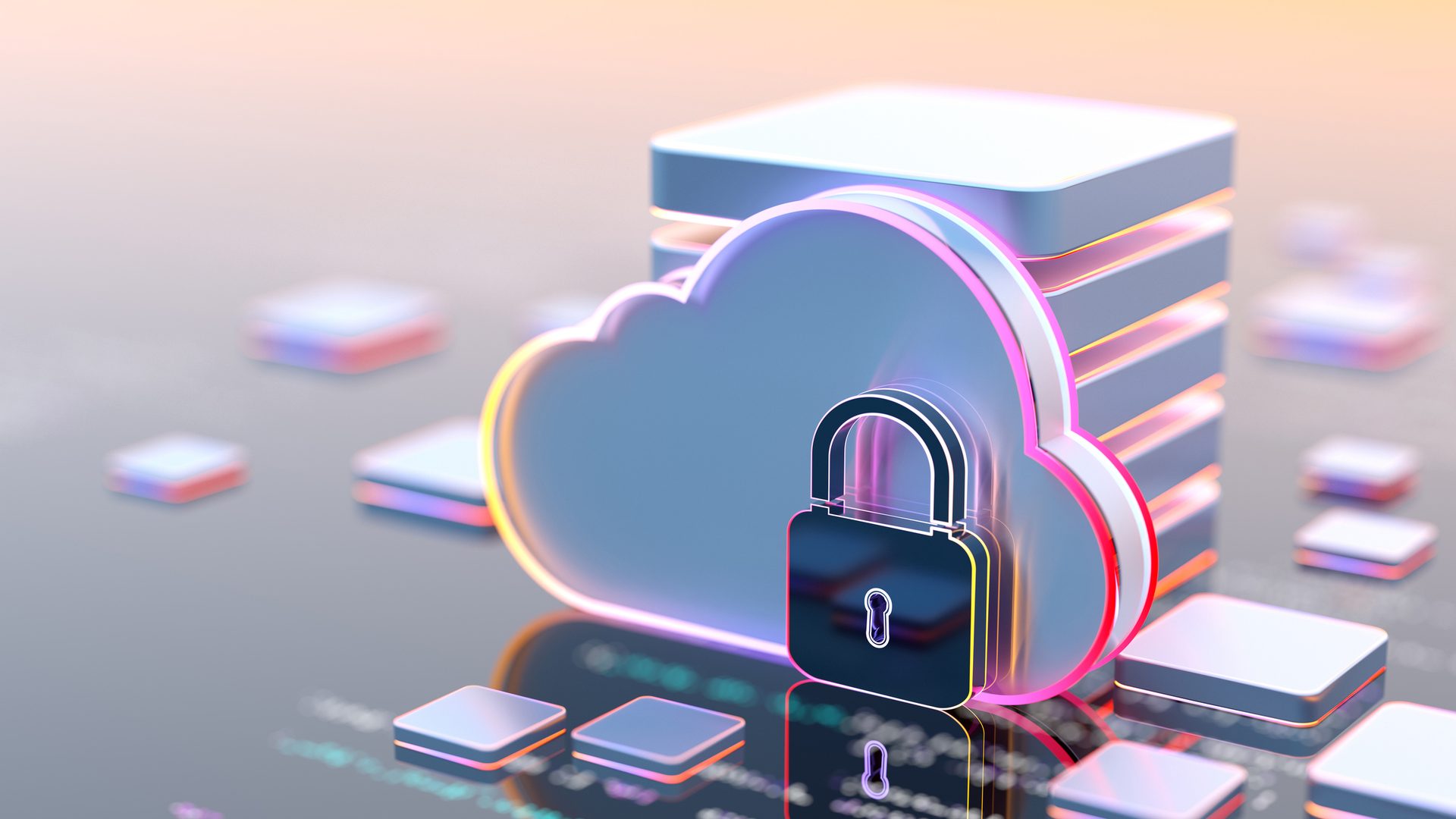march 2025
// Communication & Infrastructure
How Cloud Architecture Shapes Security
Experts explore the pros and cons to processing and storage at the edge, in the cloud, and the advantage to taking a hybrid approach to cloud architecture.
By Christopher Crumley, SDM Associate Editor


Cassie Griffin, president and founder, Griffin Security and Technology. Image courtesy of Griffin Security and Technology.
Background image / Kulpreya Chaichatpornsuk / iStock / Getty Images Plus / via Getty Images
Cloud architecture is streamlining hardware and software management for both the end user and the security dealer/integrator, offering impressive flexibility and scalability. It also has been able to generate user excitement; integrators say users are approaching them asking to go to the cloud. But at the same time, it can be difficult to navigate when cloud is fully effective, when an on-prem solution may be worth considering, and how exactly to configure a hybrid approach — which many experts indicate may truly be ‘the best of both worlds.’
Trends Taking Us to the Cloud
While talk of the cloud may seem decades old, the technology has really matured into viability only relatively recently. Bandwidth improvements may be chief among trends that have bolstered cloud’s practicality. “When I started, businesses still had 100-megabit networks,” recalls Christopher Zenaty, president, Turing AI, Palo Alto, Calif. “Imagine trying to stream multiple cameras to the cloud on that network. That would choke the bandwidth. It would end all other business activities — activities that would have been considered to be more important. Now, bandwidth capabilities are obviously significantly more. You can have multi-gig networks going to your house.”
The amount of data that can be processed in the cloud has increased and so have the capabilities of the camera. Laurent Villeneuve, senior manager, product marketing, Genetec, Montreal, says, “There was so much development in terms of what the cameras can do — the amount of processing power they have. They can now ingest so much metadata and give that to the VMS to get better results. That really helps in the transition. Initially, if you wanted to detect intrusions or to do things like ‘find the red shirt,’ it would be very complicated. You’d need a separate server where you would take all the video to be processed and sent back. And if you tried to do that through cloud services, it would completely overload the system.”
This increased bandwidth has also enabled camera resolution and capabilities to soar, but at an increased cost. “Today we see mainly 2-megapixel cameras, but image resolution is pushing towards 5-megapixel,” says Adam Lowenstein, America’s product director, i-PRO Americas, Houston. “That could be a challenge in some cases from a cloud standpoint, especially as some may be moving towards 4K and higher. So it just means you’ve got to be able to budget or manage the cost of the solution if you’re pushing that much video, if you’re storing all of it in the cloud.”
This cost can be prohibitive for some deployments, causing some integrators to be cautious about the technology, but this also presents an opportunity for manufacturers to continue improving. “I think the biggest change that will be coming will be on the video side,” says Louis Boulgarides, president and CEO, Ollivier Managed Security, Los Angeles. “Someone is going to figure out how to reliably get video to the cloud economically. At this point, bandwidth is still a concern in many cases. While edge camera solutions are a work-around, they corner the customer into working with a single company that may not be desirable for some. There are bridge devices that have greater flexibility, but again, bandwidth is an issue.”
Ultimately, Patrik Pettersson, senior manager, future business and strategic initiatives, Axis Communications, Chelmsford, Mass., points to end user excitement around cloud as an invaluable trend. “If you read any kind of cloud utilization reports, cloud has got people excited,” he says. “The expectations of our users are changing. They are getting more familiar with the cloud and they’re wondering, ‘Why can I bank, do my expense reports and my HR payroll on the cloud, but I can’t see my cameras or my system through the cloud?”
The cloud can simplify the management of multi-site organizations significantly. AerialPerspective Works / iStock / Getty Images Plus via Getty Images

The amount of data that can be processed in the cloud has increased and so have the capabilities of the camera. Khanchit Khirisutchalual / iStock / Getty Images Plus via Getty Images

Why Cloud-First?
A cloud-first approach means designing the solution around the cloud’s capabilities. Systems and data are both processed in the cloud rather than by technology on-site. Justin Wilmas, executive vice president, sales, acre security, Plano, Texas, defines the cloud-first approach as, “Everything in the cloud, where there’s no need for any additional devices. You connect to an internet browser and everything’s there, just like we do with a lot of things today in our day-to-day life.”
And what are the benefits of going cloud-first? Wilmas says, “It’s very simple — it’s highly scalable, highly flexible. You can scale up and you can scale down as fast as you need to, because there’s no infrastructure required. And this is why IT departments really love it. Gone are the days of needing multiple servers and extensive IT infrastructure to support a system.”
Wilmas continues, “What does that really mean? Traditionally, you’d have your server that an access control system would run on, and then more than likely, you’d have the database of that system on a separate server — on a database server — and then on top of that, you’d have additional servers for redundancy, clustering, or high availability or fault tolerance. And all of that comes with a cost. And then, by the way, the servers only have a shelf life of three to five years. So guess what’s happening every three to five years? Same with your database, your software and everything else. So [with] cloud-first, just forget about all that. It’s just included in the price of entry.”
Put simply, Satish Raj, chief technology officer, Pro-Vigil, San Antonio, Texas, says, “Our preferred approach is cloud-first as it is easier to control costs and deployment: the cloud is essentially like renting resources that you can turn on and off as needed.”
There’s a simplicity to the cloud-first approach, and there’s also a flexibility in commitment to certain services and applications. “Let’s say that there’s an AI application — most reside in scalable data centers and in the cloud — that you’re interested in,” Pettersson explains. “Cloud allows you to adopt very quickly and test if they’re right for you. This could be an end user who’s self-developing something. This could be an SI who stands up managed services and they want to get statistics on their devices. In an intelligent way, you can very quickly test your solution and test its feasibility directly to cloud. And once you decide that you’re going to scale this, then you can move it to hybrid. What cloud-first allows you to do is to try something quickly. You can turn on and off services very quickly before you commit; and you can make sure it’s right for you before you do any on-prem investment.”
Cloud-First Hesitations
There aren’t many downsides to cloud-first, but they’re worth mentioning. On-premise technology has its strengths and its limitations as does cloud-based, and for that reason experts may err on the side of a hybrid solution. “People thought they could do everything in the cloud, but they are realizing that it sometimes can be cost-prohibitive and they want to move back to on-prem,” Pettersson says. “I would advise that when you’re picking a vendor, pick somebody that has that flexible capability in their offering, meaning they can take that journey together with the SI.
“Do you want to be all cloud? Perfect. I can give you that,” Pettersson says. “But once you buy that hardware, if you change your mind and want to go hybrid, can that technology go hybrid? Finally, should you decide you don’t even want to be hybrid and you want to be just on-prem, then can the technology you already have installed go to just on-prem?”
There are also two old fears haunting the cloud-first approach. The first one is internet connectivity. “Obviously you’re dependent on internet connectivity,” Wilmas says. “In today’s world, that’s really not that much of an issue, but it can be. Look, if the internet is down for too long, there’s probably bigger issues in the world we’ve got to be worried about.”
The other is the cybersecurity of the cloud (see sidebar, “Cybersecurity Concerns”).
Cybersecurity Concerns

Funtap / iStock / Getty Images Plus via Getty Images
End user perception of cybersecurity in the cloud is complex. There’s a contradiction in the idea that the cloud brings increased cyber risk, yet one of the selling points is increased cybersecurity. So what’s the deal with the cybersecurity of the cloud?
Well, first of all cybersecurity is everyone’s responsibility. “Cybersecurity is not just the responsibility of your vendor; there is public, generalized training around cyber best practices out there,” says Patrik Pettersson of Axis Communications .
And Pettersson says it’s an ever-changing component of the cloud. “There’s an ongoing development — one that shall never stop — and that is cybersecurity,” he says. “It’s constantly evolving because the threat keeps evolving. When cloud entered the security industry, we were probably very risk-averse and didn’t adopt it very fast because of perceived risks of cybersecurity. There are many new standards coming out, and a lot of vendors in this industry are compliant with these standards. Axis, for instance, has just implemented SOC2 compliance and we’re moving towards Federal Information Processing Standards (FIPS) and National Institute of Standards and Technology (NIST) regulation. These may seem like just acronyms and words, but they are relevant.”
Lowenstein stresses that it’s important for the integrator to do their research into the solutions they’re offering in order to ensure cybersecurity. “Be aware of the cybersecurity policy of that edge device,” he says. “Time and time again, we’re hearing about attacks in the market and no end customer wants to be put in that position because they chose a device that wasn’t as secure as it needed to be. Again that’s another opportunity for the security integrator to bring forward a cybersecure solution.”
Zenaty challenges the perception of cyber vulnerability. “Some think, it’s cloud, it’s not going to be safe,” he says. “They think, ‘Someone’s going to hack into this system.’ Well if you have a lot of local hardware, there’s a bigger chance of getting hacked. Ask them how they do their banking. I have a banking app on my phone and I have my life savings connected to that app. How is that any less secure than the security app, which is not going to any local server?”
On-Prem, On-the-Edge & How They Fit In
It seems that definitionally, on-the-edge — or on-the-device — can be splitting hairs between being an on-prem or a hybrid solution as the storage of video on-the-edge or the processing capabilities on-the-edge can potentially fit into both an on-premise solution or into a hybrid environment. I-PRO’s Lowenstein elaborates, “Some solutions store the video on-the-edge. And we understand that they may have some cloud archiving capabilities. But really, I would call that a hybrid solution. I think it depends on how each person would classify that. I would call that a hybrid solution because it’s a cloud-managed device and it’s cloud-accessible through a web browser.
“But video is being stored really at the edge in that case,” Lowenstein continues. “So I don’t know if that’s cloud at-the-edge. I would call that a hybrid approach. That’s an interesting approach because you don’t have centralized video. And there could potentially be some downfalls where if a camera goes down, you may lose that video. There are arguments for a centralized approach fully in the cloud. If you’re going to go to the cloud, manage your video in the cloud.”
Boulgarides agrees that at-the-edge most closely resembles a hybrid approach — with its own pros and cons. “Cloud at-the-edge is similar to hybrid but would be a case where a camera, for example, had 30 days of storage on it and then it can be viewed in the cloud. This is great from a reliability standpoint, since each camera is basically its own NVR. If one goes down, the others continue to record. The con to this is that these systems tend to be proprietary, so using one technology would not allow for the use of a best-in-class camera by another company, for example.”
The hope with on-the-edge solutions is that the device would be an all-in-one solution — which is quite similar to an on-prem solution. “There’s edge computing, and we want to make sure that we have the most powerful device as far as analytic capabilities at the edge,” Lowenstein says. “And then there’s edge recording. We’ve got a lot of people coming to us right now and they want to make the camera pretty much the complete device with the VMS on the device.”
Mark Barbaric, senior vice president, technology integration, Prosegur Security Integration, Herndon, Va., offers his perspective on edge devices. “On the edge device, all the computing power is there on the device,” he says. “The data isn’t being sent halfway around the world to a virtual server or … actual server and calculated and then sent back. The processing is happening at the edge. There are some pros and cons behind that, but again, it goes back to the IT infrastructure and the bandwidth availability that the customer has on site. All of this has to be considered with edge devices.”
Ultimately, there are gaps in both the cloud’s capabilities and the device’s capabilities. Dean Drako, CEO, Eagle Eye Networks, Austin, Texas, says, “Some realize they can’t do AI on their on-prem system practically — it’s too hard. It takes too much hardware. [they] can’t maintain it, and it turns into a big mess. Many have tried.”
There’s also a small, sometimes overlooked, pain point. “It can be pretty painful to pull the footage if it’s on-the-edge storage,” Drako adds. “You sometimes have to drive there in order to do it.”
Because of this, many experts agree that a hybrid approach offers the most comprehensive, complete and flexible solution.
The Hybrid Approach
Finally, we arrive at hybrid. This approach can leverage the strengths of both on-prem solutions and fill in some of its gaps with the benefits of cloud environments. “The hybrid approach could be cloud in one instance, and then maybe an on-prem solution in another instance, but it would still be one solution,” Wilmas says. “There are some pretty interesting reasons why you would set up that way.”
Lowenstein says i-PRO is embracing both sides — or the hybrid approach. “What that means is flexibility for the end user,” he says. “Some customers want to continue to invest in an on-prem solution, but are looking for cloud features. They want a remote management tool or something where they can access that video easily without punching a hole in the firewall. And they want to be able to see all their cameras globally at their fingertips. Some are just looking for cloud archiving. I’m going to have 30 days on site and I’m going to store the rest in the cloud because I have a six-month retention policy or something like that. So I’m going to do cloud storage by offloading my video more long term.”
When our customers — especially our commercial customers — contact us and say they want to be more secure, they’re looking to us for advice almost like a doctor. So when we go with a cloud or hybrid cloud, they know that they can trust that recommendation and that we can explain to them why that monthly fee makes it better for them.
— Cassie Griffin, Griffin Security and Technology
Zenaty agrees, saying Turing AI also embraces the hybrid approach. “We went to a hybrid model where you could have local storage for the 24/7 recording, but all the analytics are done in the cloud because the processing power and capabilities of the cloud far exceed what you could do locally.”
Boulgarides cautions, however, that there are two potential “cons” in this case. “One is that there is a need for hardware and potential failure of that hardware at the client’s site and the need to make sure client-side hardware is cybersecure and that all patches have been updated. The other constraint is bandwidth. While storing video on site reduces that need for bandwidth, requests to view video live can tax that available bandwidth of the on-site systems.”
Hybrid opens the door to scale up and scale down, and it unlocks the freedom to increase or decrease user reliance on the cloud. “The biggest pro I see is the increased compatibility and a much smoother transition to cloud — to SaaS technology really — at your own pace,” Genetec’s Villeneuve says. “That’s why a lot of customers are asking us about our hybrid offering. They’re looking for that because they have things they want to keep in place, but they’re opening a new site in Ireland, and they want maybe an appliance there, a camera here, and minimal pain.”
As integrators work with end users, the hybrid approach can get a bit complicated. This leads to an increased responsibility for the integrator — and an increased opportunity for continuing support that can be leveraged as an additional source of income. “Hybrid is more of a blend of technologies,” Villeneuve continues. “You’re looking at connecting some on-prem systems to some cloud applications dedicated to certain operations. If you look at your entire deployment, maybe you’re going to pick and choose what works best at every point in time for every location and every department. So it can get pretty complicated. I would say in terms of the architecture, making sure that everything’s going to work for each location is something that requires a lot of help from your channel partner or from the tech provider.”
Where’s the Data Stored?
There are standards, regulations and legislation determining where the data is actually being stored, because — as Wilmas puts it — the cloud is not magic and that data is somewhere. “General Data Protection Regulation (GDPR) is a big trend,” he says. “Cloud can have challenges depending on how the systems are set up and where that data is being stored, because you have to be able to keep that data somewhere.
“That’s what people don’t really think about,” he says. “They use this term cloud, and people often look up to the sky, and they think it’s like magic. It kind of feels that way, which is really cool. But at the end of the day, all that data still exists in data centers. And those data centers are all over the world. So how do you make sure that the data that you have is being stored in the right location, in a data center inside the country of origin?”
GDPR is a law in the EU that — among other things — regulates that data should remain within its country of origin. Wilmas continues, “In the United Kingdom or in Canada where GDPR is really strong, the data can’t leave that country. You may have an on-prem solution running that same cloud software and connected through the internet, but the data for that country is staying within that country.”
What is ‘Private Cloud?’

MF3d / iStock / Getty Images Plus via Getty Images
For those looking for the benefits of the cloud without exposing themselves whatsoever to the public internet, there is a solution known as ‘private cloud’ or ‘closed cloud.’
“There’s what could be called private cloud, which means you’re basically deploying the cloud software in your own environment, maybe in a virtualized instance, but you’re using it internally versus externally,” explains Justin Wilmas of acre Security.
Patrik Pettersson of Axis Communications adds, “You may not open yourself up to cloud as in public cloud, but that doesn’t mean you can’t create WAN connectivity through your environment and have a central data center.”
Justin Wilmas of acre security elaborates further. “What that means is you take the cloud solution, like cloud software, and you install it in a virtualized environment. So you take that virtual software and you install it on a server inside of an organization, maybe protected behind a demilitarized zone (DMZ) — a subnetwork buffer to prevent unwanted traffic — protected behind firewalls. Maybe the organization is not accepting cloud, or has security reasons to avoid cloud, and all that typically relates to compliance in highly regulated industries such as energy.
“In a lot of those scenarios, you have to go private cloud,” he explains. “You bring everything in, you protect it behind a firewall, behind a DMZ, and it’s a cloud-based software, but it doesn’t have any outside connections. It’s totally segregated. But then you still have all the benefits of how the cloud software works — it’s all HTML, it’s all browser-based. There’s no software to install on PCs. You do everything through a web browser, all of that type of stuff. And it’s inside your own IT department; your IT department has control over everything.”
Who’s Going to the Cloud?
There are certain verticals that naturally gravitate towards or away from cloud, but that is changing as the technology advances and becomes more trusted by end users. “In my opinion, I think cloud adoption spans most verticals and most industries in today’s world,” Lowenstein says. “I think one way you could classify it is by size of deployment. I think what we typically see, which is not the rule, is a smaller camera deployment tends to be more cloud VMS attached. I think part of that is because when you look at total cost of ownership for the solution, when you get into a large-scale system — a sophisticated system, a multi-site system — I won’t say that cloud can’t handle it, but I do think that’s where you start to see more of an argument for an on-prem solution.”
Wilmas agrees that the smaller deployments trend towards cloud. “Small-to-medium business (SMB) instantly go to cloud for a lot of reasons,” he says. “There’s no high upfront cost. It’s super accessible. It’s really easy to use. They can scale up. They can scale down. It’s an OpEx to them versus CapEx.”
Other verticals that are looking at the cloud-first approach include retail, banking and education. Villeneuve says all three are starting to talk about cloud quite a bit. “We kind of expect for the shift to happen in a high volume, where a lot of schools and banks will migrate to the cloud,” he says. “Retail is a bit more regionally dependent. In some cases, they have so many sites, it would make perfect sense to go to cloud, but maybe there are compliance issues; maybe there’s very limited infrastructure. Bandwidth — in some cases — can put the brakes on that transition to cloud.”
Organizations — like those in the retail vertical — with multi-sites can streamline the management of those sites with cloud-based solutions. “It’s a perfect solution for retail with multiple site footprint across the country,” Barbaric says. “They want limited involvement in the management of password patches, firmware updates and software updates. Retail doesn’t like to get into that stuff. They’re just not set up for it. Their loss prevention officers just don’t want to deal with it, so they push that to the integrator.”
Barbaric continues, “So we’ve had a couple of pretty large customers — large by footprint, small sites and multiple sites across the country — that were looking for the hybrid model because their locations are remote. Their locations just don’t have the infrastructure requirements for true cloud video.”
And Pettersson adds that hybrid specifically can help larger organizations manage the cost of service. “Larger organizations — as well as mid-sized organizations — have realized that a hybrid approach is the most attractive way to balance your service costs for these types of applications.”
Who’s Hesitant to Go to Cloud?
There are certain highly regulated verticals that are still hesitant on cloud-based solutions and services. Most experts agree that — like the concerns of internet connectivity — this hesitation is aging out of the industry as the internet continues to become as reliable as anything else and more individuals who have grown up alongside it enter the workforce.
As for the industries that remain a bit hesitant, Wilmas lists utilities and critical infrastructure. “They’re highly regulated,” he says. “They have very stringent regulations on how data is shared and how people get access to the systems. But those are also evolving. The next generation of those regulations are evolving and becoming more open to cloud and putting in ways for organizations to adopt cloud, just because it makes sense. Everything’s going that way.”
Villeneuve adds, “Cloud can be more difficult for correctional facilities, armed services and even gaming. For casinos, it’s not the kind of architecture that they’re looking for.”
And from time to time, some just prefer on-prem solutions to anything cloud-based. “It’s rare to find people who just don’t want to adopt, but there’s some out there for sure,” Wilmas says. “There are people that are just used to their super small systems. ‘I’ve always done it this way and I want a server on-site. I don’t want to have to worry about internet connectivity or anything like that. And I would just rather have it under my control.’ And that’s a preference, and that’s fine too — everyone has their preferences.”

To some, the cloud may seem like magic; but that data is real and it is stored somewhere — and this should be a huge consideration for manufacturers, integrators, and end users. matejmo / iStock / Getty Images Plus via Getty Images
Generating Recurring Revenue
Cloud lends itself well to the subscription or recurring revenue model — software-as-a-service (SaaS). Sometimes it can generate fear, Wilmas says. “I think there’s some fear that end users can contract directly with manufacturers for cloud, and it cuts out the integrator,” he explains. “That’s not the case at all. It allows the integrators to get into the recurring revenue business, and that’s super valuable.”
Lowenstein adds, “As the integrator, you can help do the health monitoring; you can help with the firmware updates; you can do some training for the staff. There’s a lot of value in that.”
It provides an ease of service for the end user, as well as the integrator. For example, you can respond to customer concerns remotely. “No matter what size integrator you are, you are really trying to figure out how you’re going to offer managed services,” Pettersson says. “You want to be able to service your customers at your fingertips while you’re out on another job, You don’t want to have to get back to the ‘answering machine’ in order to then call that customer back. You want to have utmost flexibility to log into their system remotely.”
It can lead to certain benefits, like a reduction in truck rolls. “You can remotely troubleshoot before you have to roll a truck,” Wilmas says. “If you have a service maintenance agreement with a customer, the less you roll trucks, the more profitable you become. If you can do more things remotely, the better off you are. So, those are things that are really beneficial and really exciting for integrators. It’s a new technology. It’s something new you have to learn, and you have to change how you think, how you talk, and how you sell.”
Pettersson advises, “It’s important to start questioning your vendors on what tools they are giving you when you commit to be a loyal reseller of their technology. What tools can you get from that partner to manage all these systems that you’ve deployed? You need to look at how that integrates with your ticketing systems. How do you, for instance, start getting a history of when you’ve visited this one customer? You’ve visited this one corner camera five times, so there’s probably something wrong with the camera or there’s something wrong with the cable. How do you start using modern tools that help you identify that you’ve visited this camera before and quite often?”
And, Pettersson believes it’s important to remember that there are third party applications out there that integrate with multiple vendors. “I also think they need to start looking at what systems exist out there that are already integrated with vendors as well,” he says. “There are third party systems and platforms out there that are starting to aggregate multiple vendors. For instance, if you’re not an integrator who’s loyal to one vendor, you’re not going to want five apps because you sell five brands — you’re going to want one aggregated interface that sees all vendors. Start looking around in the industry to see what third-party applications are out there. And I can tell you that some larger integrators are starting to put their own development resources to work to build their own asset management platforms.”
Finding the Right Solution
At the end of the day, integrators are tasked with finding exactly the right solution for their customers. Cassie Griffin, president and founder, Griffin Security and Technology, Columbus, Miss., compares the relationship — and the trust between end user and integrator — to that of a doctor and a patient. “Some like a full cloud, some like hybrid, and then there still are some small use cases where I would say there’s local only,” she says. “When our customers — especially our commercial customers — contact us and say they want to be more secure, they’re looking to us for advice almost like a doctor. So when we go with a cloud or hybrid cloud, they know that they can trust that recommendation and that we can explain to them why that monthly fee makes it better for them “We used to be a shop that would sell you a camera system that doesn’t have a monthly subscription, and that was a selling point for people because customers felt like everything wanted a monthly subscription,” Griffin explains. “But after a few years of operating the business, I came to realize that I was setting my customers up for a bad experience or to be statistically likely to have a negative experience at some point. Now, we’re of the mindset that yes, it is a monthly fee, but the benefits that you get with that monthly subscription far outweigh the monthly fee for the system.”
This transition to cloud offerings came after working closely with a specific vertical. Griffin was presented with a unique challenge and needed to find a unique solution. “We were searching around for a cloud video solution two years ago because we connected with the vertical of public safety,” she explains. “Our local police department needed something to respond to crime and didn’t really know what to do.
“At the time, they couldn’t hire more officers,” she continues. “They wanted something that would provide eyes around the city. So I had a conversation with one of the leaders of the department, and I asked, ‘We want to help, what can we do?’ They said, 'Find me more officers.' I’m sorry I can’t do that, but what if we put cameras on utility poles around town? And they asked, ‘Can you do that?’ I told them we could figure it out.”
So Griffin did. “I ended up building a mounted cabinet system that they could mount on their utility poles wherever they wanted throughout the city to be a 24/7 eyes in the sky,” she says. “This helped aid the officers that they did have, and this was a perfect instance of a time that the system was not intuitive enough and not easy enough for an officer or an investigator to use confidently.”
That led Griffin to the simplicity of cloud-based VMS solutions. “We were searching around for something that we could put inside these systems that we built, but that an officer who is not a tech guru — who is not an IT administrator — could quickly pull footage, could quickly send footage to another investigator.”
Griffin currently deals with Eagle Eye Networks’ offerings.
Advice on Selling the Cloud
Amidst the confusion of navigating what end users believe cloud to be, and the many slightly varied definitions of what constitutes a hybrid approach or an on-prem solution, the experts offered these words of advice as guiding lights. “Focus less on cloud itself, because it’s a means to an end,” Villeneuve says. “They’re not looking to buy your cloud. They don’t care about that. They’re looking for better ways of securing their facilities, so start with that. Start with, ‘I can help you safeguard those people better. I can help you protect privacy here. I can help you be much more efficient here. And then I can help you kind of become a profit center instead of a cost center.’”
Villeneuve also stresses that flexibility to decide exactly when to be on-prem and when to go to the cloud can be a great comfort to customers, because “One of the biggest pains is the burden of choice,” he explains. “The customer feels pressure to choose to go all in on one approach — on one architecture — with very little time or assistance to prepare that migration plan, and that's the worst situation for them.”
Finally, Bill Brennan, president, i-PRO Americas, advises, “There’s great benefit in the long run in truly understanding what the customer’s needs are. And there’s great benefit in determining what’s the best option for them in terms of a services option as well as a financial option. Because in many cases, there’s a price tag that comes with cloud. People sometimes don’t realize it until they get so far down the road. So we pride ourselves on really trying to educate our team to ask questions. Don’t just tell them they need cloud. What do you really mean? What are they really looking for?”

